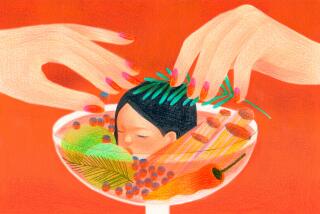This Clear’s for You : As Sales Shrink, Brewers Are Trying to Cook Up Excitement
- Share via
The first to go were the calories.
When Miller Brewing Co. officially introduced Lite beer in 1976, heads shook and palates braced for the first real departure from traditional American beer.
In the 1980s, Lite beer’s phenomenal success amid a flattening beer market inspired brewers to unleash all sorts of convolutions in search of new niches.
They tried beer with low alcohol. And no alcohol. They added corn syrup for more alcohol. They made dry beer. They went beyond light beer to ultra-light and to the darker, more filling extreme. They bottled draft beer. They made beer from wheat instead of barley, corn and rice. And they introduced malt-based coolers.
Some have worked. Most haven’t survived the test phase. None of them managed to reverse the beer industry’s slowing growth.
Enter Miller’s newest permutation: invisible beer. Earlier this month, the Milwaukee-based company introduced Clear Beer in three test markets in Austin, Tex., Minneapolis and Richmond, Va.
Clear Beer still tastes like beer, has foam like beer and contains calories like beer. It doesn’t look like beer, though. It’s one of a string of new, clear products, like clear cola, clear dishwashing detergent and clear deodorant.
To analysts, Miller’s reason for making beer clear is anything but crystal clear.
“To call it beer and take out the color, what the hell for?” said Joseph Owades, director for the Center for Brewing Studies, a beer-making school in San Francisco.
Miller’s response has been that Clear Beer is less harsh and filling than other brews, yet retains “big beer taste.” It’s being marketed to mainstream adult beer drinkers as “a great beer-drinking beer.”
A Clear Beer still has 122 calories--more than any light beer--which isn’t likely to appeal to women or traditional beer drinkers except as a novelty item, said Tom Pirko, president of BevMark Inc., a consulting firm for the beverage industry.
Unlike Coors’ Zima, a clear malt beverage introduced last September that tastes like gin and tonic, Clear Beer isn’t establishing a new taste category, analysts said.
What is clear is that Clear Beer is an attempt at innovation, increasingly the buzzword for the big three of brewing: Anheuser-Busch Inc., Miller and Adolph Coors Co.
Overall, beer shipments in 1992 fell by 800,000 barrels, or 0.4%, according to the Beverage Marketing Corp. in New York. The industry has dipped 2.7% since 1990. No. 1 Budweiser dropped 7.9% in that period, and its 1.4-million-barrel loss in 1992 was the greatest of any American brand.
Miller--a subsidiary of Philip Morris--declined by 3.3%, while Coors and Anheuser-Busch were up slightly. Shipments from other major breweries, such as Stroh, Heileman, Pabst and Genessee, fell for the eighth straight year.
Beer companies offer a litany of reasons for the slowing sales: a poor economy, rising health consciousness, excise taxes and a shrinking population of new drinkers.
Amid the failures, some new products have stuck, none more so than light beer. Miller’s Lite remains the second-best-selling beer, after Budweiser, though imitators such as Bud Light and Coors Light are right behind.
No-alcohol beer finally caught on after the introduction in 1990 of O’Doul’s (Anheuser-Busch) and Sharp’s (Miller). The category grew by 37% last year. And draft beer, fueled by Miller’s Genuine Draft and Genuine Draft Light, continued to make gains.
Strangely, the newest beer craze, microbrewing, has been largely ignored by the big three. While the 294 U.S. microbreweries and brewpubs accounted for just 0.6% of beer sales in 1992, the craft brewing industry expanded by 41% in 1992 and sales topped 1 million barrels for the first time.
At various times, the big brewers have made half-hearted attempts to cater to the import and microbrew crowds. Anheuser-Busch briefly test-marketed Anheuser Marzen (1984-87) before discontinuing it--despite good results--to free up brewery space for its bigger-volume products. Miller recently released Miller Reserve Amber Ale to try to tap the high-end category.
The big three say they are relatively unfazed by the surge in microbrewers. “We don’t view them as a competitive threat,” said Julie Demlow, a spokeswoman for Coors.
Instead, the big brewers have focused on establishing new product categories so they can offer a menu of choices to the consumer. Today, there are 10 recognized segments of the beer industry.
Old standby brands such as Budweiser and Original Coors fill the “premium” segment, with pricier brands like Michelob, Lowenbrau or Heineken selling as “super premium,” “domestic specialties” or “imports.” Discount beers such as Meisterbrau and Milwaukee’s Best are sold as “popular” brands.
With the exception of light beer, sales in all of the major categories have been declining, with premium beers suffering the most. The category has dropped steadily since 1982.
Perhaps more than at any time in their history, the major breweries are due for a dramatic about-face. BevMark’s Pirko, for one, predicted brewers’ attitude toward the high-end microbrewing market will change. In the future, he said, “people will drink less but they will drink better and pay more. They will trade up.”
The Beer Market
As sales of most other beer categories continued to decline in 1992, light beer appears to have surged past premium beer to become the biggest seller.
Market share in percent
1988
Imports: 5%
Popular: 20.6%
Light: 26.4%
Premium: 41.1%
Others: 6.9%
1992
Imports: 5%
Popular: 18.9%
Light: 34.5%
Premium: 34.3%
Others: 8.1%
Source: R.S. Weinberg & Associates
Note: 1992 figures are preliminary estimates
More to Read
Eat your way across L.A.
Get our weekly Tasting Notes newsletter for reviews, news and more.
You may occasionally receive promotional content from the Los Angeles Times.










